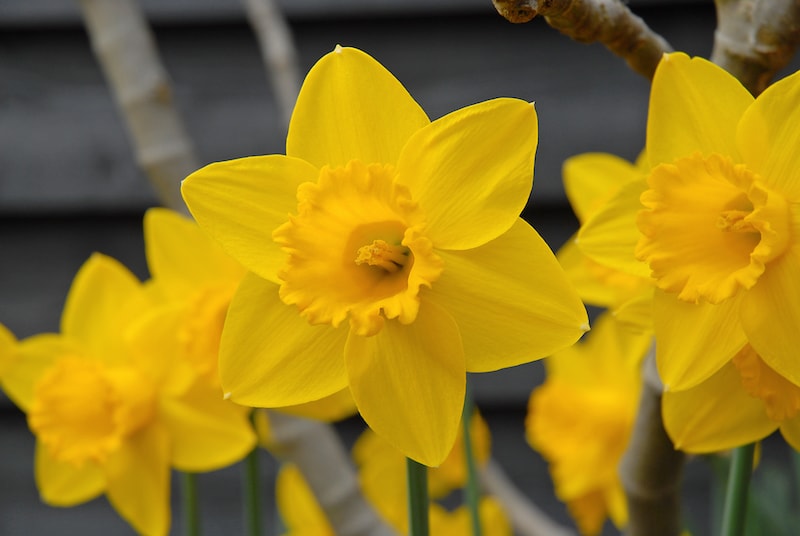Daffodils, also known as narcissi, are iconic spring flowers that come in an astonishing variety of colours, shapes and scents. We’ve gathered expert advice from our favourite gardening bloggers to show you how to get the most from these hardy perennials. With a bit of care, your daffs will return year after year to brighten borders, patios and hanging baskets.
When you’re ready to start planting, browse our full range of daffodil bulbs including everything from traditional yellow ‘trumpets’ to delicate frills of pink and cream.
Contents:
- Best advice on planting daffodil bulbs in the ground
- Best advice on planting daffodil bulbs in containers
- Best advice on naturalising daffodils
- Best advice on caring for your daffodils
- Best advice on storing and forcing daffodil
Best advice on planting daffodil bulbs in the ground
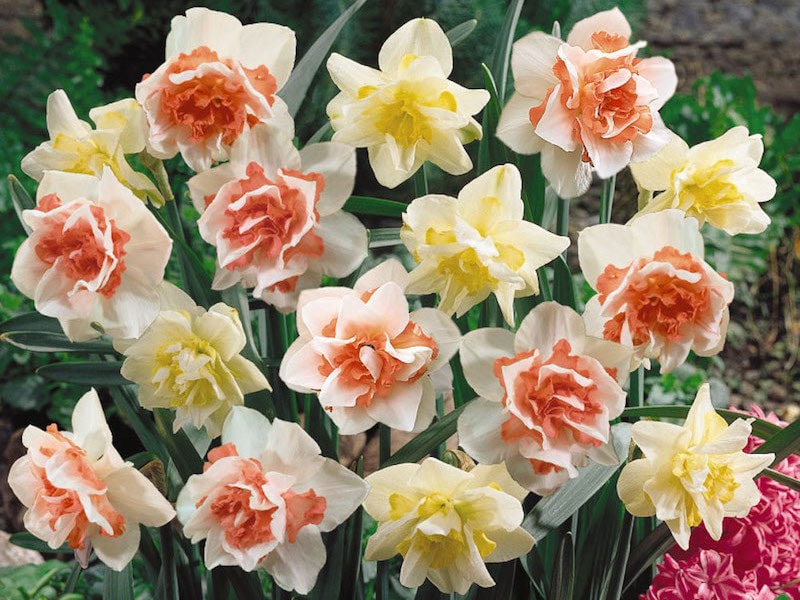
Copyright: Visions BV, Netherlands
John Moore at Pyracantha recommends planting your daffodil bulbs between September and November by burying them “at twice the depth of the bulb itself, so an average of 15-20cm below the surface of the soil.” In his comprehensive article on how to plant daffodil bulbs, John explains that shallow planting can cause your daffs to come up ‘blind’ (flowerless).
For Mandy Watson over at MandyCanUDigIt, planting at the right depth is key to success. She recommends investing in a bulb planter, which neatly removes a plug of soil to the required depth and then drops it back on top of the planted bulb. Mandy uses a hand-tool bulb planter for her narrow borders, but says that a long-handled version is useful for heavy soils. If you have to guess the correct depth, Mandy advises erring on the side of too deep, rather than too shallow.
When growing daffodils, grouping your bulbs close together will create a fuller and more natural display than planting them thinly or too evenly, according to the gardening experts at the Suttons blog. They also remind us that daffodils are popular with pollinating insects, so it’s good to be generous when planting!
If you aren’t a fan of the traditional yellow daffodil, Becky @gardening_the_good_life invites you to explore the wonderful world of narcissi. “I’ve loved ‘Replete’, ‘Sir Winston Churchill’ and ‘Cheerfulness’… those ruffled petticoats that just keep giving and the dreamy scent,” she says. Having actively avoided classic golden daffs, Becky’s enthusiasm for “creamy, peachy, ruffled, highly scented, multi headed” narcissi is infectious!
After planting your daffodil bulbs, it’s a good time to mulch your flowerbeds, says Mandy over at MandyCanUDigIt. This blanket of mixed organic matter keeps weeds down, provides insulation over winter, and is a quick and easy way to make your garden look tidy. It will eventually be incorporated into the soil, improving the quality.
Best advice on planting daffodil bulbs in containers
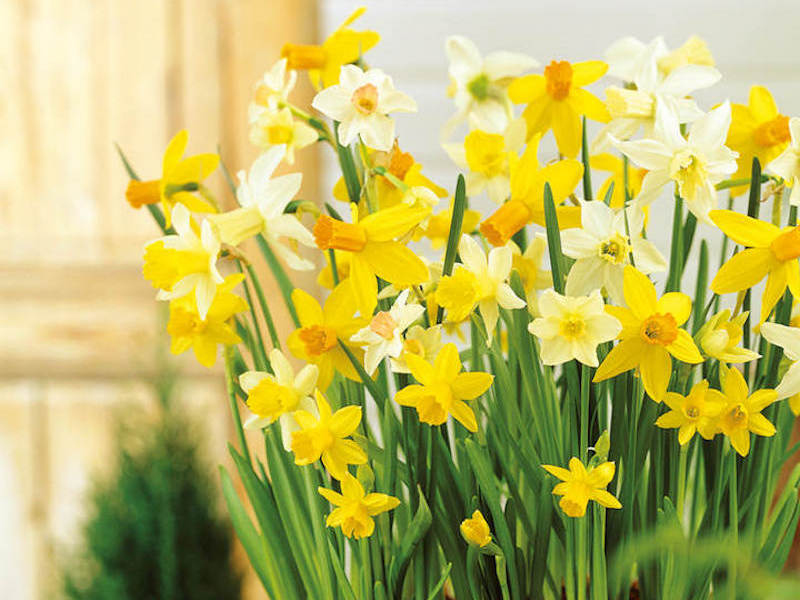
Copyright: Visions BV, Netherlands
When planting in pots, John Moore of Pyracantha warns that the bulbs shouldn’t be in contact with each other or with the sides of the container. While bulbs can be planted closer together when grown in pots, planting them too close to each other can cause them to come up ‘blind’ or flowerless.
Good drainage is essential when growing your daffs in containers. In her guide on how to plant a ‘bulb lasagne’, Catherine Hughes from Growing Family recommends putting pieces of broken pottery in the bottom of your container to help it drain, and to be wary of overwatering, as “bulbs hate sitting in cold, soggy soil.”
A ‘bulb lasagne’, as Alan Down of Down To Earth explains, refers to “planting spring flowering bulbs in layers one on top of the other [to] extend the flowering season.” It’s a very effective way to plant up patio pots, and Alan has some great recommendations for other bulb varieties to grow along with your daffodils. If you choose varieties that flower at different times of year, you’ll be rewarded with an ever-changing display that lasts for months.
If you don’t have the space for containers, you can also grow dwarf narcissi in hanging baskets. Watch Roger Crookes’ YouTube video to see how he cleverly creates a hanging ball of flowers using daffodil ‘Tête-a-Tête’, brightening up the garden at a time of year when his baskets would usually be empty.
Best advice on naturalising daffodils
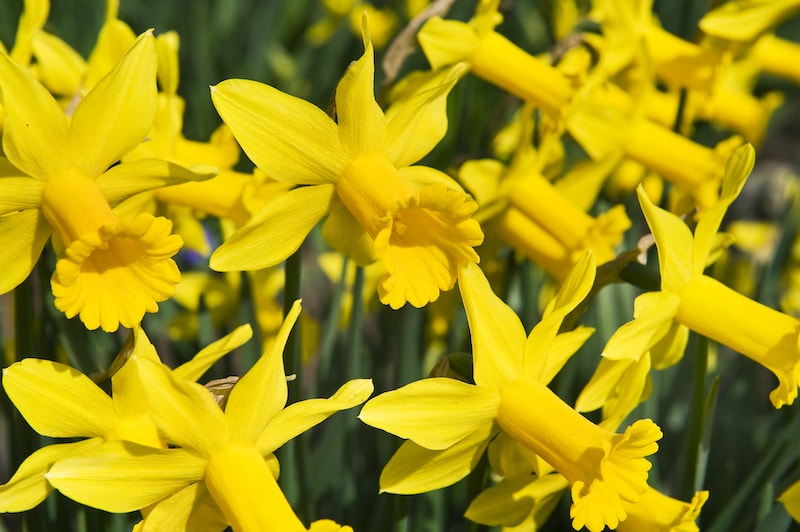
Image: Daffodil ‘Peeping Tom’ from Suttons
Naturalising your daffodil bulbs simply means planting and then “leaving them in position after flowering to allow them to self-seed and propagate themselves naturally.” If this is your aim, the horticultural team at the Suttons blog recommends choosing a sunny spot in the garden with enough space for the flowers to return in larger clumps year after year.
Over at Down To Earth, horticulturist Alan Down suggests a list of daffodils, narcissi and hybrids that are best for naturalising. Alan doesn’t think you can beat the classic yellow native British daffodil, but he also recommends ‘Tête-a-Tête’ and ‘Thalia’. See his full article for more variety advice.
When naturalising daffodils, it’s important to plant them in a ‘natural’ way. In this excellent article, Alexandra Campbell of The Middlesized Garden asked Lucy Adams (head gardener at Doddington Place Gardens) for tips on planting spring bulbs. According to Lucy, the best results come from throwing mixed handfuls of bulbs across a lawn and simply planting them where they fall.
Alternatively, John Moore of Pyracantha suggests that the quickest and easiest way to plant daffodils under grass is by cutting and lifting sections of lawn with a spade, before dropping the bulbs underneath and placing the turf back down. Using a mix of different varieties enhances the natural effect.
Best advice on caring for your daffodils
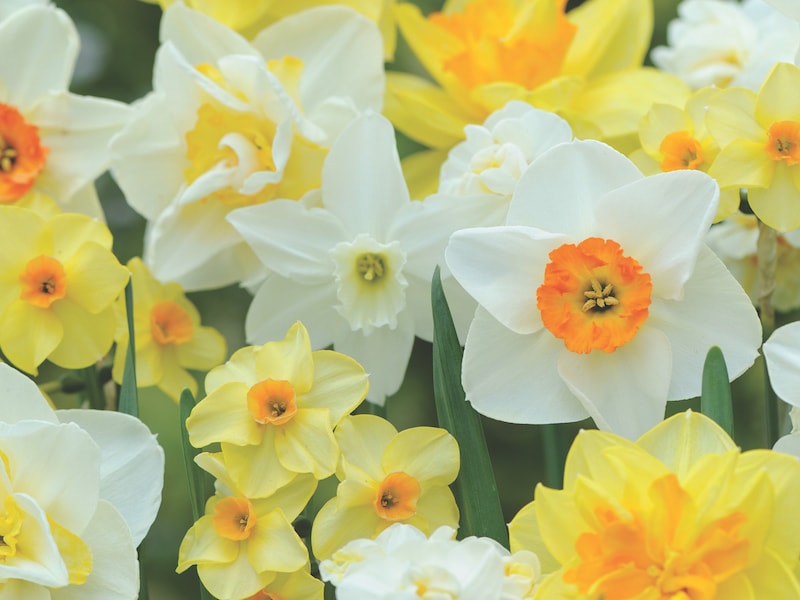
Image: Daffodil ‘Value Mixed’ from Suttons
Although daffodils more or less take care of themselves, for a strong display that returns year after year, follow Simon’s advice on deadheading over at Gardening at 58 North. In his video he clearly explains the rationale behind removing old flowerheads and seed pods to bolster future growth.
As Hannah at Talking Of Plants notes, deadheading is a quick and easy job that will benefit your daffodils in years to come. In her easy-to-follow deadheading guide, she explains how removing the flower by cutting just beneath the swollen part (inferior ovary) “stops the plant expending its energy into seed production and instead ensures it puts energy back into the bulb.”
Harriet at Dack’s Gardening Services advises that you shouldn’t cut the foliage of your spent daffodils back until it has gone brown. Waiting for it to die back naturally means that the nutrients will be absorbed by the bulbs, giving them the energy they need to produce more flowers next year.
Simon of Gardening at 58 North also warns against cutting back the leaves too soon after flowering – he explains that as long as they’re green, they continue to provide the bulb with energy from sunlight. For the same reason, he doesn’t recommend tying up drooping foliage, as doing so limits the surface area available for converting sunlight into energy.
Over at Gardeners Cottage Blakeney, this excellent video demonstrates how to divide and rejuvenate clumps of daffodils that are no longer performing at their best. Having flowered for 40-50 years, their daffodil bulbs are now congested and coming up ‘blind’. They recommend unearthing the bulbs ‘in the green’ (before the foliage dies back), then simply dividing and replanting them with “some more space, fresh compost and a good feed.”
It’s best not to replant your divided bulbs in groups larger than about three to five, as they will just become congested again, explains Lee Burkhill over at Garden Ninja. In Lee’s helpful, step-by-step guide to replanting bulbs ‘in the green’, he recommends using the straightforward ‘slit method’. This just means cutting into the ground with a sharp spade to create a channel for your bulbs. See his full article for more tips.
Best advice on storing and forcing daffodils

Image: Daffodil ‘Tête-à-Tête’ from Suttons
You don’t have to dig up and store daffodil bulbs once the foliage has died back – they will quite happily wait underground until next spring. However, if you live in a very wet area, you do run the risk of losing bulbs to rot in waterlogged soil. If this is the case, John Moore of Pyracantha recommends lifting your bulbs in late summer and storing them somewhere cool and dry until you’re ready to replant them.
If you’re storing dormant bulbs, Dan Cooper at The Frustrated Gardener explains that it’s essential to “keep them cool, dry and dark”. He recommends keeping them in a well-ventilated paper or cardboard container (never plastic) , and checking weekly for signs of deterioration. He diligently removes any bulbs found to be going soft or mouldy, as these would soon contaminate the rest.
If you can’t wait until spring to see your daffodils bloom, it’s possible to force narcissi to flower earlier by putting the bulbs through a ‘false winter’ and growing them indoors. Rachel at The Good Life Ain’t Easy will inspire you with her quick guide to growing paperwhite narcissi in time for Christmas.
The horticultural team at Suttons’ blog also recommends forcing paperwhite narcissi (Narcissus papyraceus) for a traditional display and heady scent over the festive season. According to these experts, they take half the time between planting and flowering compared to other narcissi. Check out the full how-to guide for more practical tips.
Whether you’re planting your daffodil bulbs in the ground or containers, we hope this selection of expert tips helps you to brighten your home and garden with stunning displays.
Lead image: Daffodil ‘Golden King Alfred’ from Suttons
Last Updated on August 1, 2025 by Suttons Horticultural Team

